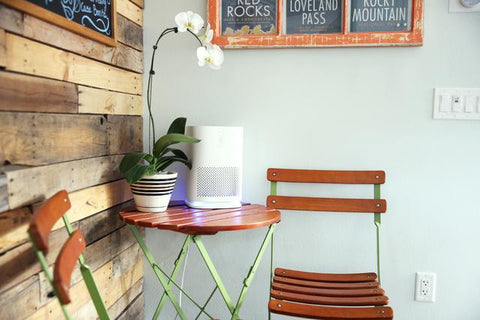How Can an Air Purifier Reduce Your Allergies?


Allergies are a major problem for many Americans. The American College of Allergies, Asthma, and Immunology reports that 50 million Americans suffer from allergies. That fact makes allergies a major chronic illness
Allergies can be further triggered indoors due to several sources, such as:
- Dust
- Mold spores
- Pollen
- Pet and animal dander
- Smoke
- Volatile organic compounds (VOCs)
- Insects
So, do air purifiers really help with allergies? The short answer: yes. But how?
Purchase a HEPA air purifier
The quality of an air purifier makes all the difference in fighting allergies. We recommend true HEPA air purifiers, which can remove 99.97% of particles down to 0.3 microns in diameter. These filters effectively remove common allergy triggers from your air. Pollen particles range from 10 to 1000 microns in diameter, dust particles range from 2.5-10 microns in diameter, and mold spores range from 3-40 microns in diameter. The web of fibers, which make up the True HEPA filter, easily traps the most common allergens.
As mentioned in our previous article there are different levels of HEPA quality. Medical grade HEPA is even more powerful than True HEPA and removes even smaller particles from your air.
We also recommend choosing an air purifier that does not produce high levels of ozone. The American Lung Association says that the O-Zone levels produced should not exceed 0.05 parts per million. When purchasing an air purifier with an ionizer, be sure to check whether low levels of ozone are produced. All Medify air purifiers are CARB Certified by Intertek to ensure against the production of ozone.
Replace filters regularly
We can't overemphasize the importance of proper maintenance to make sure air purifiers work effectively. The filters should also be changed regularly to ensure they continue to remove harmful allergens. The filter life will vary between air purifiers; however, a well-designed pre-filter will help prolong the overall filter life. Of course, you might need to replace them more frequently if you have high amounts of particles due to a recent move, renovation, or other circumstance.
Medify is thrilled to announce our Filter Club, which allows customers to subscribe and save for automatic replacement filter deliveries based on their air purifier model. Customers are able to manage and keep track of their subscriptions through the customer portal and will be notified a couple days before their payment is due for the next delivery.
Air purifiers must be placed carefully
It’s also important to place your air purifier in an optimal location. Sometimes the placement can be just as important as the quality itself. Most people will place their air purifier in the corner or pressed closely up against the wall. For some models, this blocks the air purifier intake and limits the amount of air to be filtered.
Placement is especially important when the air intake surface area is smaller. Air purifiers need space on all sides to operate efficiently, so we suggest placing the model in an area where the intake is not blocked.
Depending on your allergies, one air purifier may not be enough. If you have an air purifier in your living room and begin to experience allergy relief, your symptoms may worsen while you sleep in your bedroom. Ideally, you want to have an air purifier in rooms where you spend most of your time. Usually this tends to be the living room and bedroom – or even an office space. Medify offers several medical grade air purifiers for different sized rooms, making it easy to reduce allergies throughout your home.
Invest in the best purifiers to fight allergies
Allergies are a major pain for tens of millions of Americans. Fortunately, quality air purifiers can make a big difference. Allergy sufferers need to buy the right air purifier, set it up carefully, and replace filters regularly. We are pleased to do our part to help Americans suffering from allergies by creating powerful medical grade air purifiers. Check out our various models to learn what works best for your needs.